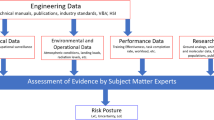Abstract
Due to the highly constrained schedules and budgets that NASA missions must contend with, the identification and management of cost, schedule and risks in the earliest stages of the lifecycle is critical. At the Jet Propulsion Laboratory, it is the concurrent engineering teams that first address these items in a systematic manner. Foremost of these concurrent engineering teams is Team X. Started in 1995, Team X has carried out over 1,000 studies, dramatically reducing the time and cost involved, and has been the model for other concurrent engineering teams both within NASA and throughout the larger aerospace community. The ability to do integrated risk identification and assessment was first introduced into Team X in 2001. In this paper, we describe how the Team X risk process is evolving, highlighting the strengths and weaknesses of the different approaches.
Similar content being viewed by others
References
Wall S, Smith D, Koenig L, Baker J (1999) Team structures and processes in the design of space missions. In: MTG: 1999 IEEE aerospace conference, Snowmass at Aspen, CO, USA, March 6–13
Warfield K, Hihn J (2009) Spreadsheets in Team X: preserving order in an inherently chaotic environment. In: Proceedings of the 42nd Hawaiian international conference on system sciences (HICSS 42) Waikoloa, HI, January 5–8
Kluger J, Cray D (2005) Management tips from the real rocket scientists. Time Mag
Moeller R, Borden C, Spilker T, Smythe W, Lock R (2011) Space missions trade space generation and assessment using the JPL rapid mission architecture (RMA) team approach. In: IEEE aerospace conference, Big Sky, Montana
Meshkat L, Oberto RE (2004) Towards a Systems Approach for Risk Considerations during Concurrent Design. In: United Nations Space Conference, Beijing, China
Malone M, Moses K (2005) Development of Risk Assessment Matrix for NASA Engineering and Safety Center (NESC), Project Management Challenge
Hihn J, Charttopadhyay D, Hanna R, Port D (2010) Identification and classification of common risks in space science missions. In: Proceedings of the AIAA space 2010 conference and exposition, 1–3 September 2010, Anaheim, CA
Morgan MG, Henrion M (1990) Uncertainty: a guide to dealing with uncertainty in quantitative risk and policy analysis. Cambridge University Press, UK
McCormick NJ (1981) Reliability and risk analysis: methods and nuclear power applications. Academic Press, Orlando
Author information
Authors and Affiliations
Corresponding author
Additional information
This research was conducted at the Jet Propulsion Laboratory, California Institute of Technology, under a contract with the National Aeronautics and Space Administration ©2011 California Institute of Technology. Government sponsorship acknowledged.
Rights and permissions
About this article
Cite this article
Hihn, J., Chattopadhyay, D. & Shishko, R. Risk identification and scoring in early-lifecycle concurrent engineering teams. Innovations Syst Softw Eng 8, 213–221 (2012). https://doi.org/10.1007/s11334-012-0187-2
Received:
Accepted:
Published:
Issue Date:
DOI: https://doi.org/10.1007/s11334-012-0187-2




